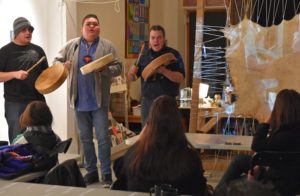Indigenous Art—From bush to table to stage

By Kelly Anne Smith
NORTH BAY—The White Water Gallery was bustling with great works and with creative people gathered for the successful Up the Ante Indigenous Art & Anti-colonial Art Show & Auction.
Indigenous art has always been part of the artist-run gallery says executive director Serena Katoaka. “Our founding members included Indigenous people. There have been Indigenous exhibitions since our founding 40 years ago.”
Katoaka explained the Up the Ante Art Show began with a huge donation.
“A member of the community with a private collection donated a ton of work to us and wished to have a show that celebrated Indigenous art but also to raise money for the gallery,” recalled Katoaka.
As a delicious buffet fed the gathering, Up the Ante offered more to feast the eyes and senses. Russell Noganosh paintings of swirling playful colours and curvy purple tulips lifted spirits.
Articulate painter Mitchell Ellam is Ojibway/Cree and calls himself a city walker.
“I’ve been to the reserve twice in my entire life,” stated Ellam. “I’ve attended one pow wow, ever.”
The 23 year-old spoke of his self-portrait being about the rediscovery of his Indigenous identity.
“It’s not so much the face here or the one in the mirror,” noted Ellam. “It’s past that. It’s about what’s really underneath the skin.”
Sid Bobb, originally from Vancouver now a pride of North Bay, partnered with Penny Couchie, a pride of Nipissing First Nation, on the installation piece What is Art? They are co-directors of Aanmitaagzi. In his speech, Bobb recognized Keith Campbell and Mike Couchie for helping to start White Water Gallery.
Speaking to What is Art? Bobb posed the question, “Is it art going from bush to table to stage?” The installation included the projection of the filming of harvesting a deer onto its stretched hide in a frame. The community harvest project took place over three days.
Bobb explained that as guest artist Eva Couchie began to work on the animal in a rawhide making workshop, Dan Commanda pulled into the driveway with beautiful tools.
“There is a resurgence and revitalization for Indigenous ways,” added Bobb.
Penny Couchie said her inspiration for the installation was her father.
“We were going out to get materials with my parents for birch bark tea making,” recalled Couchie.
Penny asked her Dad at which point was he making art? He replied, “I wouldn’t say I was making art. It’s a way of life. This is who we are as Anishnaabe people.”
Penny told the group that her parents both tan hides.
“They harvest wild foods and they make customary art or traditional arts,” stated Couchie. “They have learnt from many different people over the years including their own parents, grand-parents and great grand-parents. They always said to remember the way we do things.”
“Right from the time we harvest roots, when we pull roots or we gather bark or hunt deer or we harvest fish and take scales or porcupine and pull the quills- it is a way of life and art making,” continued Couchie. “When we were doing the hides, Dan Commanda came along with his tools and to learn the techniques my Mom was showing. And he showed us his techniques and that is the way we do things. We often share our ways.”
It was Commanda who pointed out that there is no word for art in Anishinaabemowin.
A young woman spoke up explaining there is a connection to the animal. “A spiritual respect is given to the animal for sustenance and survival.”
Penny Couchie said all parts are used.
“This deer’s toes will be used for my Uncle’s outfit. The bones were roasted and the marrow taken out for broth. We butchered the meat. The brain will be used for tanning. The hide will be a drum,” explained Couchie.
Installation and performance artist Meg Paulin of Nipissing First Nation exhibited a warrior spear soaring high in the air. Paulin called art an innate ability.
Jacob Richard Dayfox from Sheshegwaning First Nation with Steven Rickard and Gerry McComb, cousins from Moose Factory sang an old song.
Tasheena and Thaila Sarazin performed a hand drum song. Tasheena said that The Strong Woman Song was chosen to honour the strength of their mother Katherine. “My mother passed a lot of this knowledge down to me. I hope to do the same with my children.”
Thaila exhibited her art work as well.
The White Water Gallery artists have recently renovated to create a sound/media cubby, a studio space and a new local gallery shop—all to support the exciting local arts scene.


